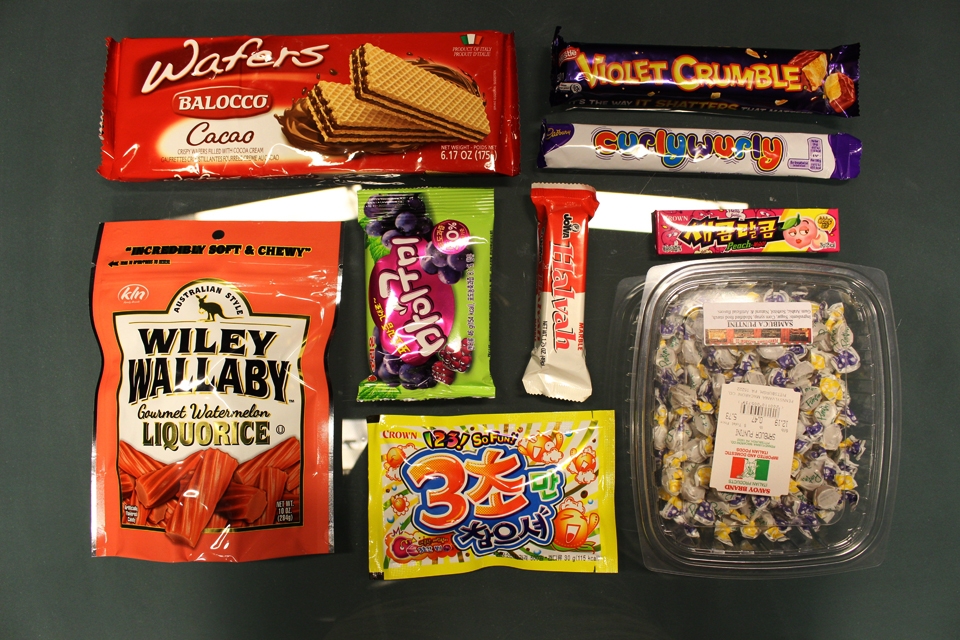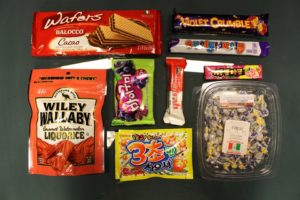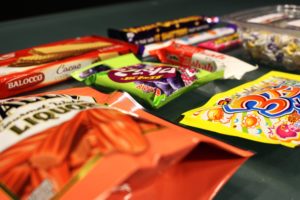

By Seth Culp-Ressler | Features Editor
It’s safe to say I have a bit of a sweet tooth. After all, what is college if not a time to eat all the sugary junk food in the world sans any serious guilt?
With that in mind, I was pretty eager to try out the foreign spread of candies and treats laid out before The Duke Dabbles team for this inaugural test. The results weren’t quite as amazing as I was hoping for.
We started with the more traditional, non-chocolate options. Most were, to be completely frank, average at best. The watermelon liquorice from Australia was just pretty much like every other liquorice I’ve ever had, the Korean grape gummies tasted like regular gummies (despite the cough syrup smell) and both the Korean sour peach chews and Korean mini, gobstopper-like balls are great for those with a proclivity for the sour sensation. And I mean really sour. Not a fan.
The standout loser of the group was the Italian sambuca puntini, a black liquorice-flavored hard candy. Why anybody finds the taste of black liquorice to be in any way enjoyable, let alone suitable to be called candy, is a mystery to me. Double thumbs down.
Rounding out the test we had (mostly) chocolate-based treats. Most of these missed the mark. The Australian chocolate-covered honeycomb was weird in texture and devoid of much taste, the Italian wafer tasted like cardboard, and the Greek sesame bar is so far from candy it’s not even funny. The British Curly Wurly, a caramel-filled chocolate, was great, if a bit chewy. That’s a combination that can never go wrong.
Overall, our limited samplings cemented for me one thing: I’ll be sticking with U.S. candy for the time being. Sorry, world.

By Leah Devorak | Layout Editor
There are two things I love in life: culture and sugar. After this international candy taste test, though, one of those loves has diminished. A lot. (Hint: It’s not sugar.)
Going into this, I was truly expecting everything to be fantastic. Like, chocolate wafers straight from Italy? Watermelon liquorice made Down Under? A sesame sweet from somewhere in Greece? Heck yeah! I was dying to try them all.
But then I actually put them in my mouth, and my previous want changed to absolute regret. So much regret…
The Italian wafers tasted like paper, and the watermelon liquorice was like what I always imagined eating a scented eraser would be like. As for the sesame bar, it was just oily, sandy blah-ness. I was not a fan.
My favorite of them all ended up being the sambuca puntini, a hard candy made to taste like its namesake, anise-flavored drink. For those unfamiliar with anise, that’s what black liquorice tastes like. Lucky for me, I love black liquorice, so I loved this little disc of joy. The only weird thing about it, though, was the consistency. The longer it was in your mouth, the chewier it got, something I’m still unsure about.
Tied for second place for me were all the Korean candies, mostly ‘cause it’s impossible to go wrong with sour and fruity – unless it’s something like sour banana, of course. Good thing that wasn’t one of the flavors.
My overall consensus, though, was that, compared to what we have in the United States, these candies sucked. I think the problem is with their amount of sugar. So attention, rest of the world: You need more sugar. Sure, this is probably why Americans are fat, but at least our taste buds are happy.


